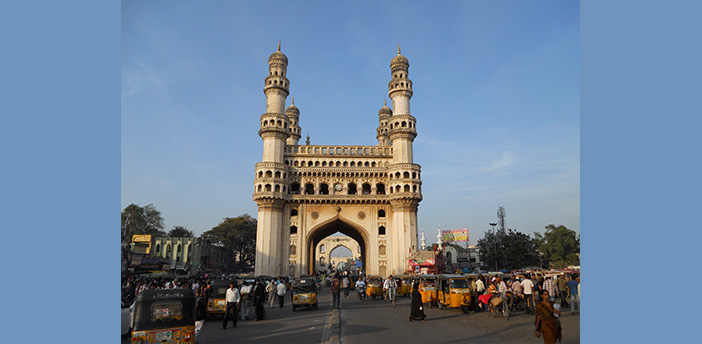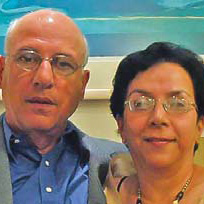Hyderabad is a classic tale of two cities – the modern IT hub with its wired population and the old-world city of the Nizams, in their time, amongst the richest rulers in the world. The style of those legendary potentates, their tehzeeb and flagrant selfindulgence have left an indelible mark on the social fabric of Hyderabad even as this metropolis reinvents itself with modern flyovers, swish hotels and boutiques, hip coffee bars and restaurants.
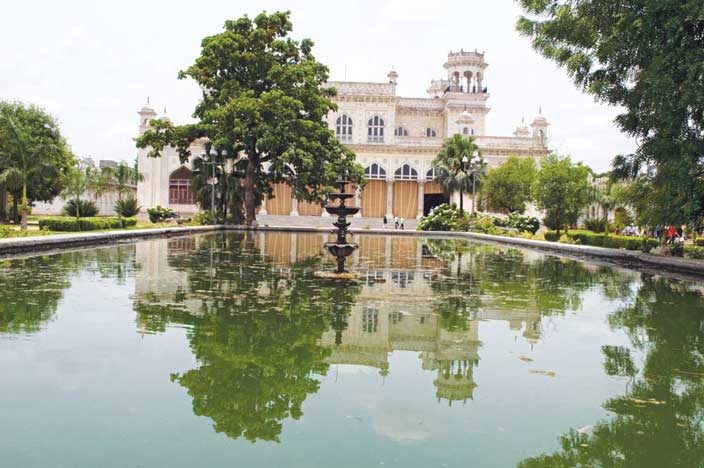

Much of the skyline remains the same with minarets pointing heavenwards and the soft toll of temple bells mingling with the sounds of raucous commerce in its bazaars. But there is a can-do spirit about the place, a swagger almost, as though this city, so rich in history yet often side-stepped in favour of its more flamboyant competitors, is finally getting its due.
The life and time of the Nizams
We got a strong whiff of that forgotten era and its whispering gentility when we met Mir Mozem Khan, a retired UN official, and grandson of Fakr ul Mulk, one of the foremost nobles in the land. We met him some years ago, in the leafy courtyard of his stately home, and he exuded noble bearing from every pore; he was truly to the manor born. The throb of modern Hyderabad was muted to a dull hum as Mir Mozem evoked for us the largerthan- life times of the Nizams.
To understand Hyderabadi royalty, Mozem Khan explained, one must appreciate the fact that the Asah Jahi dynasty of Nizams, who ruled the state, along with his nobles were the flagbearers and custodians of Mughul tradition and culture, once the Mughal Empire collapsed in Delhi. The social structure of the state was based on a feudal or jagirdari system in which noblemen were granted estates and privileges on the understanding that they would provide the Nizam with a specified number of troops whenever he might require them. “Haft hazari, or 7,000 troops, were the highest jagirdars; whereas on the end of the spectrum, there were the smaller jagirdars whose commitment was as little as 100 troops,” says Mozem Khan.

Once the British Raj was firmly ensconced in the country, the colonialists stopped the princes from indulging in their favourite pursuit – warring with each other. The need for troops became redundant though the jagirdari system survived. With wars becoming a distant memory, the Nizam and his nobles found they could give expression to their innate love for things of beauty which they were willing to buy at any price.
Soon the untold wealth of the Nizams and the excesses it nurtured became fodder for a world hungry for exotica. Tales were told of a land of milk and honey where obscenely rich kings ruled the roost… They reigned from marble palaces with extravagant lawns where peacocks flitted; a 280-carat Jacob Diamond was used as a paperweight by one of the Nizams… The stories, the stuff of fairy tales, were true. Yes, an order for 50 Rolls Royce cars (including a Silver Ghost with a body of hammered silver) was placed by a Nizam while the world whispered another outrageous story (true nonetheless) about how a convoy of 50 trucks, weighed down with gold nuggets, was mired in mud in the royal gardens.
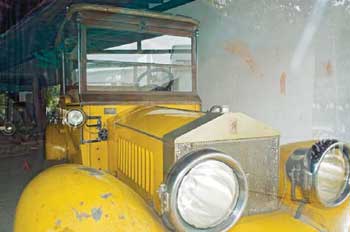
Great wealth often breeds great eccentricities and one Nizam’s passion for clothes became the talk of the town. He would wear only brand new silk socks imported from France (which it was whispered his valet promptly sold) and the royal laundry was sent to Paris. He had a wardrobe that was the longest in the world at the time and which could only be accessed by a hand-operated lift. There were 150 closets stuffed with all manner of lavish clothes that money could buy… The upper level of the palace is now a museum while the lower level has been converted into a school. However, we discovered that most of the closets were empty and it was left to our imagination to figure out what the fashion statements of the era might have been. Courtiers, noblemen and jagirdars, who saw themselves as mirror images
of the Nizams, competed with each other to match their master’s splendid lifestyle. Mozem Khan’s grandfather, for instance, built the 250-room Iram Manzil which was staffed by 927 retainers. The 400-acre complex was virtually a city within a city and housed a polo field, a lake on which boats bobbed, tennis courts, a private forest, stables for 100 horses, a garage for 20 cars, a dairy farm, a hospital and even its own private police force. Extravagance or excellence, however, one views the indulgences of the Nizam and his court… that era kept the world agog and riveted.
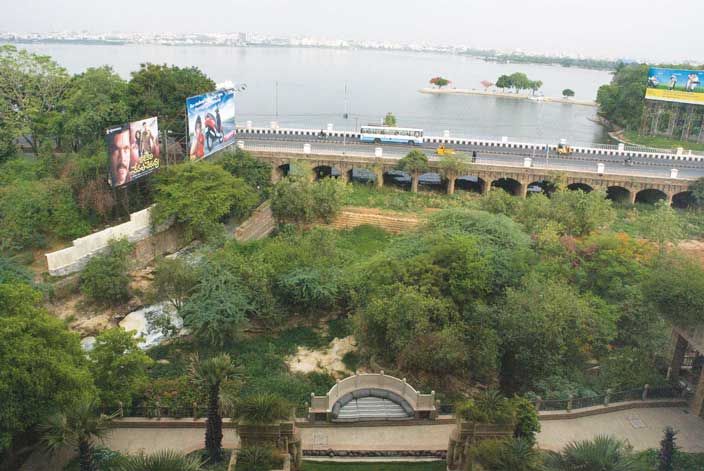
Mozem Khan recalled his first and only meeting with Shah Mirza Beig, the highest handicapped polo player of his time. Beig was in bed with a damaged spine, the result of a nasty fall on the polo ground. Five days before he died, he had asked to see Mozem Khan, then a lad of 10. When Mozem Khan arrived, he was requested to ride Beig’s favourite Arabian polo pony on the lawns outside his window. Mozem Khan rode the handsome steed and was stunned when the animal was gifted to him. It was a grandiose lifestyle that has all but disappeared in today’s world.
Many members of the old guard have managed to thrive in independent India and have adjusted to modern-day realities. Yet others subsist on dreams of a bygone era that they hope will return. They are the ones who sold their treasures, the antiques and old palaces to pay taxes and estate duties and today cling to sepia-tinted photographs and a few frayed-atthe- edges gifts to soften the grim edges of reality.

A blend of the old and the new
As the general manager of Marriott Hotel and Convention Centre, put it succinctly: “Hyderabad is one of India’s newest yet oldest cities.” And from our plush room overlooking the city’s famous Hussain Sagar lake, we saw a typical Hyderabadi vignette. Young honeymooners in rustling silk saris and tight shiny suits walking arm-in- arm down the lakeshore promenade as a clutch of burqua-clad women hurried past them shyly, eyes downcast.
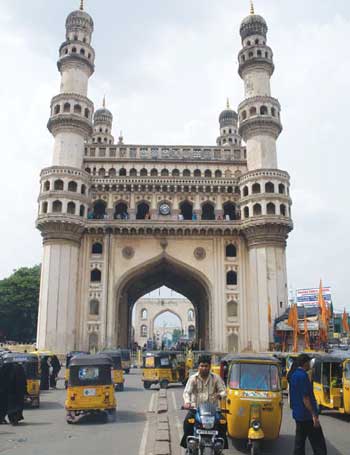
In this city of almost other-worldly charms and new enticements, we were forever chasing the compelling contrasts. Tangible evidence of its storied past pulses in the monuments that dot the city. The most recognized of these is the iconic Charminar which was built in 1591 to mark the end of a plague epidemic that had ravaged the city.
There is another story about the origins of the Charminar that is far more alluring. According to legend, this icon of Hyderabad stands on the very spot where one of the Qutub Shahi monarchs in the 16th century used to have secret trysts with a local dancing girl, Bhagwati, at this very spot. The city was then known as Bhagyanagar. Once the pretty local belle was enthroned as his queen, she was re-christened Hyder Mahal and the name of the city was changed, significantly, to Hyderabad.
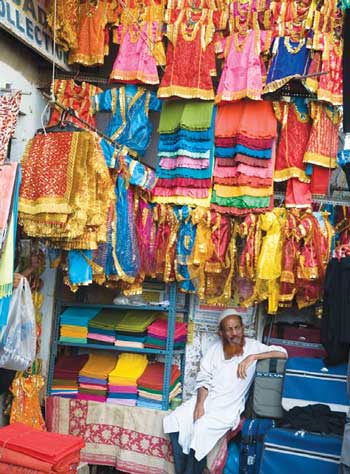
Today the Charminar is the bustling colourful heart of the city, separated from the new section by the Musi river. In this Arabian Nights setting of enthralling bazaars that flourish in the lanes and by-lanes around the monument, one can find everything from elegant lacquered bangles and bridal wear to sensuous silk, lace and exquisite pearl jewellery.
The Mecca Masjid nearby etches the horizon with its sweeping lines and within its hushed precincts lie the tombs of the Nizams of Hyderabad, forgotten for the most part by the people who once loved and admired them. Construction of the mosque was commissioned by the sixth Qutb Shahi Sultan in 1614 and it was eventually completed by none other than the Mughal Emperor, Aurangazeb. The vast interior can accommodate 10,000 worshippers at any given time and as we gazed upward at the arches, colonnades and minarets, we recalled the fact that this grand edifice took a hundred years to build. As we stepped out of the mosque, a thousand gray and white pigeons swooped into the courtyard and the next second, surged upwards in a spectacular star-burst formation across the sky.
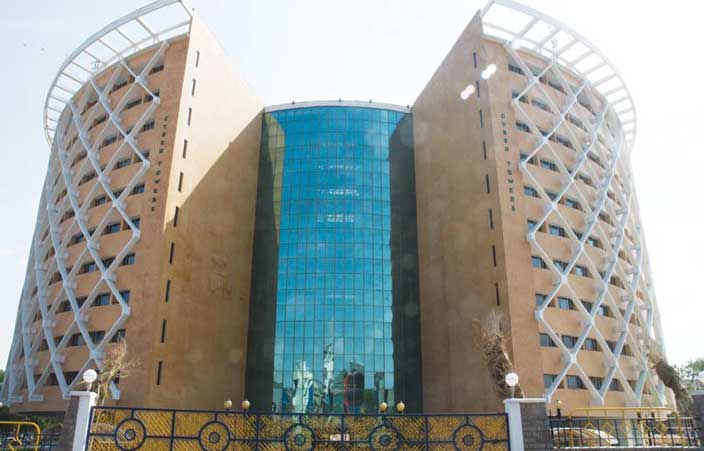
If there is one monument that is virtually synonymous with Hyderabad, as much as the Charminar, it is the Salar Jung Museum. With its 35,000 objets d’art, the obsessive collection of one man Nawab Salar Jung III, the prime minister of the seventh Nizam, the museum underscores that era’s penchant for amassing collectibles at extravagant prices. Imbued with the typical spirit of excess, the museum has 38 galleries on two floors and is said to be only a part of the larger collection. Many of the treasures were reportedly stolen by the staff of Salar Jung III and some of them were lost when the priceless treasures were shifted from the private palace, Diwan Deodi to the present location.
As we lingered to admire the exquisite beauty of the Veiled Rebecca, sculpted with stunning detail in marble by G.B. Benzoni of Italy in 1876, we were distracted by a commotion outside the room – the crowd that had collected in the courtyard in front of a clock broke into spontaneous cheers when a little toy man emerged from a cabinet in to strike the hour.
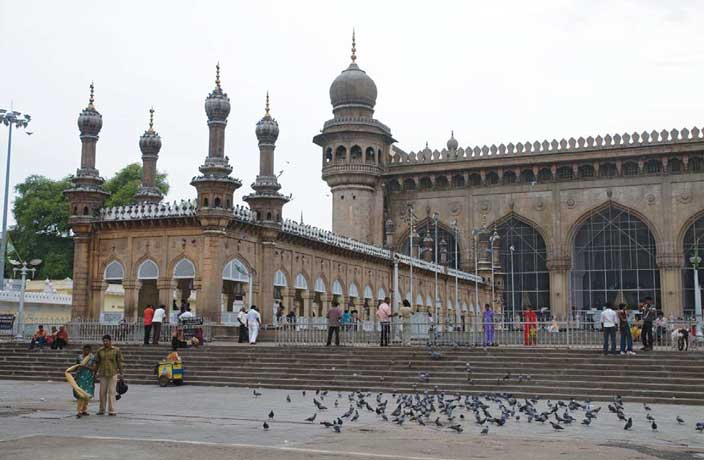
It served as a reminder that time is running out for many of the grand palaces that dot the city. Some have fallen into disrepair, crumbled and been replaced by ugly modern buildings. Others have been converted into government offices and even hospitals – the Assembly and High Court buildings, for instance. A few still remain in the possession of hamstrung nobility, straddling two worlds, trying to find a balance in an era where time is money. Sushil Kapadia, a prominent, long-time resident who lives in a gracious Nawabi mansion told us about how the King Kothi, now a government hospital, was up for grabs for Rs. 22 lakh at one time and the beautiful Falaknuma Palace for as little as Rs. 5 lakhs!
But there’s hope, for not far from the Charminar, is the resplendent palace complex of Chowmahalla, with two courtyards, palaces, gardens and fountains which sprawls over 12 acres. This was the seat of the Asaf Jahi dynasty and the palaces were restored and recently thrown open to the public. The palaces are splendid, especially the grand Durbar Hall with its 19 chandeliers and the marble platform on which the royal throne was placed. This is where royal durbars and lavish banquets were held for British royalty.
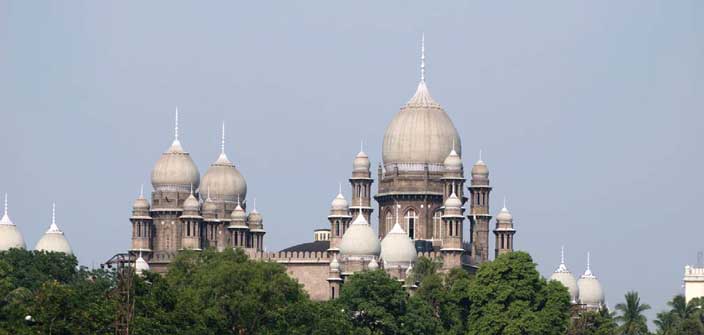
Hyderabad is a lesson learnt in very visual terms – time does not stop for any man. In this city, the past, present and the future co-exist comfortably. We toured swish Banjara Hills as much a symbol of 21st century Hyderabad, as the Charminar and the Salar Jung are of its vibrant past. At Banjara Hills, we stumbled on shopping malls stuffed with modern-day treasures, trendy eateries that serve cutting-edge cuisine and night clubs that pulsed with heady energy into the wee hours. And this, in a city where the traffic lights used to be switched off at 8 pm, until just a decade ago!
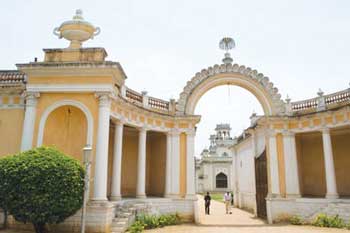
Our epiphany happened at the Laad Bazaar in the Old City where bangles winked and gleamed like the secret treasures of the Nizams. We bought a box full for our daughter and were taken aback when the shopkeeper bowed low and offered us another.”Please take it as a gift from me to you, visitors from Mumbai.” We felt like he had gifted us the grand Falaknuma Palace (now a Taj group hotel) built by the noble Sir Vicar ul Umra.
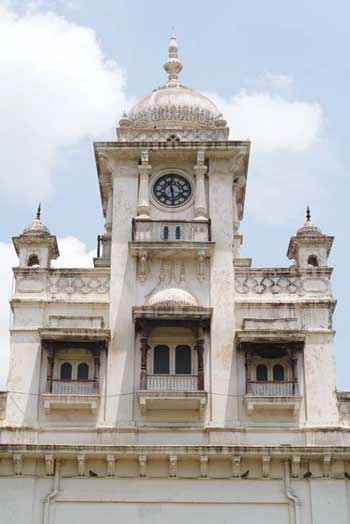
When the Nizam visited this graceful palace for the very first time, he was so bewitched by it that he chose to extend
his stay there beyond the one day that he had originally planned. In response to this open display of admiration from the Nizam, ul Umra spontaneously presented him with the palace building.
Yes, in Hyderabad, anything can happen… And as the saying goes, if wishes were horses, beggars would ride. And dreams could well become reality even in the modern world; even though the fairy wands are of a different modern kind.
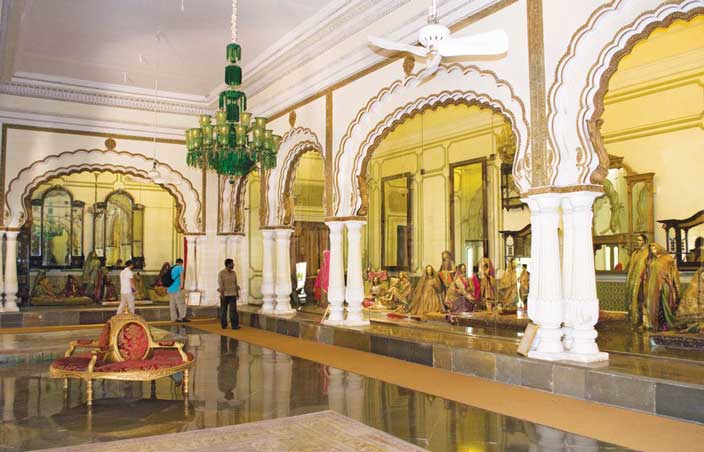
Fact File
Hyderabad, which is the capital of both Andhra Pradesh and the newly formed state of Telangana is well connected by road, rail and air to the rest of the country.
The city has a wide range of accommodation ranging from five-star to budget.
For more information visit Andhra Pradesh Tourism Development Corporation at: www.aptdc.gov.in or Telangana Tourism at: https://tourismintg.com
Golconda: The Koh-i-noor of Forts
Golconda Fort, located 14 km from the city, is a marvel of engineering. It stands on an isolated hillock, ensconced within three layers of massive stone battlements. There is a lot of clapping going on just at the entrance of the citadel. It’s to do with guides and tourists testing the fort’s unique acoustics which allows sound to carry up to the Darbar Hall at the top of the hill. In olden days, it served as an effective communication system as guards used different hand claps to give those at the top of the hill time enough to prepare an appropriate welcome for the person approaching the gate, depending on whether he was a member of the royal family, a guest or unwelcome foe.
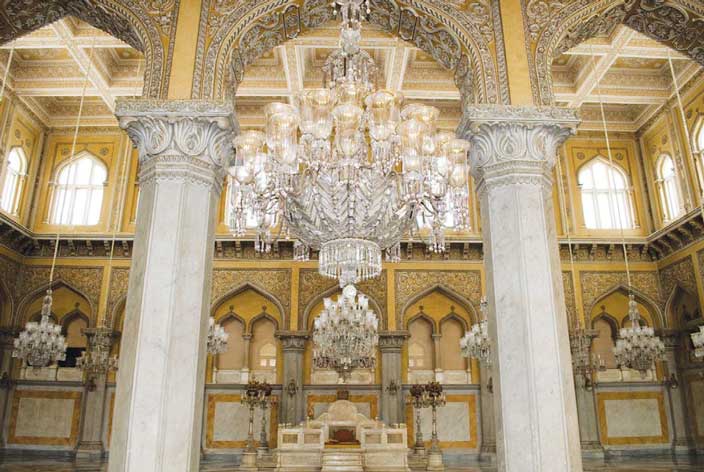
Less applauded yet equally ingenious is the ancient water supply system which continues to carry water up the hill to the citadel even to this day.
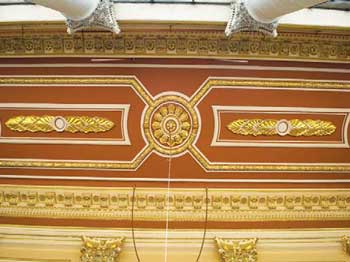
Today, the fort is a mute witness of history. Its name, Golconda, was once synonymous with diamonds and extraordinary wealth. Both the legendary Koh-i-noor (now the prized exhibit in the Crown Jewels of the British royal family) and the Darya-i-noor were mined here.
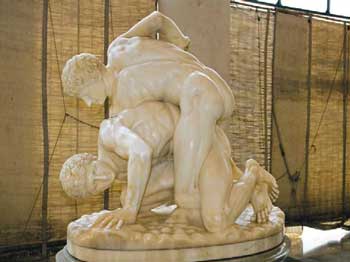
Come sundown, and the members of the audience take their seats amid the ruins for the Son-et-Lumiere show. The deep baritone voice of the narrator conjures up the ghosts of the past that seem to re-enact and re-live the dramatic moments in the history of the land they once ruled… a world of bloody battles and gracious living!
Located just one km from Golconda Fort are the tombs of the Qutb Shahi rulers; a cluster of beautiful domed monuments surrounded by manicured lawns and gardens.
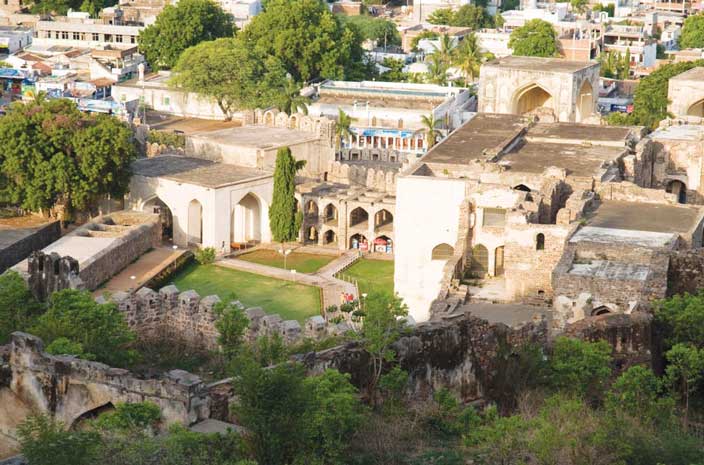
Things to do and see
Shopping
Looking for something traditional like bangles or zari work? Head for Laad Bazaar in the old city around the Charminar. The streets here brim with colour and almost ceaseless activity.
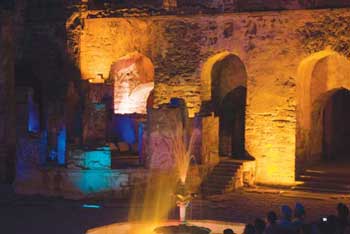
For more conventional shopping, your best bet are Abid Road in the old city of Hyderabad and S.D Road in the twin city of Secunderabad. These two streets are lined with a number of stores stocked with everything from plastic trinkets to high fashion garments that sport famous international labels.Swish Banjara Hills is where glass-sheathed shopping malls and the city’s hottest eateries and entertainment spots are located.
Birla Temple
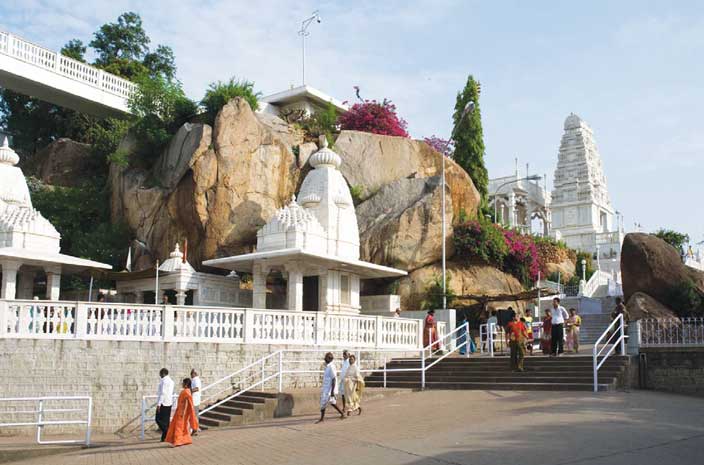
Perched on summit of Kala Pahad is the stunning Birla Temple, built entirely out of brilliant white marble imported from Rajasthan. The temple which took ten years to build is an expression of devotion to Lord Venkateshwara. From up here, you will get a panoramic view of the city.
Indulge the Taste Buds
Hyderabadi cuisine is the stuff that legends are made of. The rich aroma of biryani cooking over wood fires is enough to make one forget there is more to the city than just good food. Restaurants like Hotel Sharda and Madina Restaurant in the old city near the Charminar, where pots simmer slowly over the last hour on dum, are hard to resist. Biryani with mirchi ka salan and raita on the side; dum ka chicken and Hyderabadi naan and rotis… Indulge the taste buds. This is how the locals dine.

bangles studded with imitation stones
Chefs in restaurants attached to five star hotels conjure up local cuisine in display kitchens and make it a fine dining experience that evokes the elegance of royal banquets.
Top off the meal with soft, creamy and subtly sweet sheermal garnished with silver and rose petals. Or tuck into a double ka meetha, a crunchy delicious dessert served hot or cold with fresh cream. Yes, when a traditional Hyderabadi daavat beckons, it is hard to resist.
Pearls of Wisdom
Looking for a special gift for someone special? How about pearls? Street markets and plush boutiques and jewellery shops across the city brim with a variety of choices – from rice to whole pearls, from brilliant white to subtle hues of pink, peach, yellow or gray – and at prices that are hard to beat. It is not for nothing that Hyderabad is often referred to as Pearl City for around 60 per cent of all pearls in India are processed here.
The gems, however, come in their raw form from fresh water cultured oyster farms in China before they are transformed – boiled, washed, polished, drilled and strung – into jewellery.

From the show windows of more than 100 outlets around the city, many clustered around the Charminar, displays of necklaces of many strands, bracelets, earrings, studs and a variety of pearl jewellery wink at you. Drop in and check out the prices which range from Rs. 20 upwards per gram depending on factors such as their size, shape, lustre, smoothness and colour. Finally, three words of advice, especially if you visit smaller jewellery outlets: bargain, bargain, bargain.

